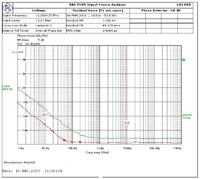N1UL
Member level 2

Look at the size of these sapphire oszillators and at the effect of a buffer stage.
Paralleling 2 transistors depends on the type , some experimenting is needed
Added after 1 hours 57 minutes:
No, HFe of the transistors will not bee the same, and this is only applicable for flicker noise in primary standards, and there a FET up to 150 MHz is the better choice.
Above these are typically VCOs and the loop takes care of the flicker noise
Paralleling 2 transistors depends on the type , some experimenting is needed
Added after 1 hours 57 minutes:
No, HFe of the transistors will not bee the same, and this is only applicable for flicker noise in primary standards, and there a FET up to 150 MHz is the better choice.
Above these are typically VCOs and the loop takes care of the flicker noise





